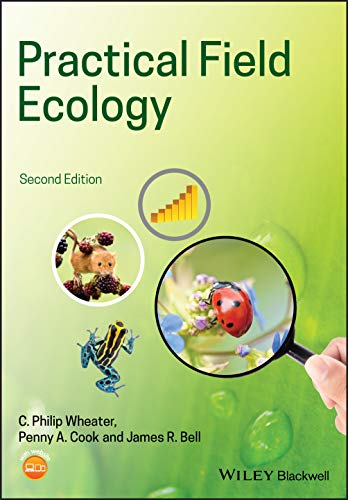9781119413226 - Practical Field Ecology: A Project Guide de Wheater, C. Philip; Bell, James R.; Cook, Penny A. (19 resultados)
ComentariosFiltros de búsqueda
Tipo de artículo
- Todos los tipos de productos
- Libros (19)
- Revistas y publicaciones (No hay ningún otro resultado que coincida con este filtro.)
- Cómics (No hay ningún otro resultado que coincida con este filtro.)
- Partituras (No hay ningún otro resultado que coincida con este filtro.)
- Arte, grabados y pósters (No hay ningún otro resultado que coincida con este filtro.)
- Fotografías (No hay ningún otro resultado que coincida con este filtro.)
- Mapas (No hay ningún otro resultado que coincida con este filtro.)
- Manuscritos y coleccionismo de papel (No hay ningún otro resultado que coincida con este filtro.)
Condición Más información
- Nuevo (19)
- Como nuevo, Excelente o Muy bueno (2)
- Bueno o Aceptable (2)
- Regular o Pobre (No hay ningún otro resultado que coincida con este filtro.)
- Tal como se indica (No hay ningún otro resultado que coincida con este filtro.)
Encuadernación
- Todas
- Tapa dura (No hay ningún otro resultado que coincida con este filtro.)
- Tapa blanda (19)
Más atributos
- Primera edición (No hay ningún otro resultado que coincida con este filtro.)
- Firmado (No hay ningún otro resultado que coincida con este filtro.)
- Sobrecubierta (No hay ningún otro resultado que coincida con este filtro.)
- Con imágenes (9)
- No impresión bajo demanda (19)
Idioma (1)
Precio
- Cualquier precio
- Menos de EUR 20 (No hay ningún otro resultado que coincida con este filtro.)
- EUR 20 a EUR 45 (No hay ningún otro resultado que coincida con este filtro.)
- Más de EUR 45
Gastos de envío gratis
- Envío gratis a España (No hay ningún otro resultado que coincida con este filtro.)
Ubicación del vendedor
Valoración de los vendedores
-
Practical Field Ecology
Publicado por John Wiley and Sons Ltd, 2020
ISBN 10: 1119413222 ISBN 13: 9781119413226
Idioma: Inglés
Librería: PBShop.store UK, Fairford, GLOS, Reino Unido
EUR 54,48
Convertir monedaEUR 4,56 gastos de envío desde Reino Unido a EspañaCantidad disponible: 15 disponibles
Añadir al carritoPAP. Condición: New. New Book. Shipped from UK. Established seller since 2000.
-
EUR 51,58
Convertir monedaEUR 9,15 gastos de envío desde Reino Unido a EspañaCantidad disponible: 2 disponibles
Añadir al carritoCondición: NEW.
-
EUR 59,02
Convertir monedaEUR 5,14 gastos de envío desde Reino Unido a EspañaCantidad disponible: Más de 20 disponibles
Añadir al carritoCondición: New. In.
-
EUR 51,57
Convertir monedaEUR 17,18 gastos de envío desde Reino Unido a EspañaCantidad disponible: 4 disponibles
Añadir al carritoCondición: New.
-
Practical Field Ecology: A Project Guide
Publicado por John Wiley and Sons Ltd, 2020
ISBN 10: 1119413222 ISBN 13: 9781119413226
Idioma: Inglés
Librería: THE SAINT BOOKSTORE, Southport, Reino Unido
EUR 62,77
Convertir monedaEUR 9,99 gastos de envío desde Reino Unido a EspañaCantidad disponible: Más de 20 disponibles
Añadir al carritoPaperback / softback. Condición: New. New copy - Usually dispatched within 4 working days. 817.
-
Practical Field Ecology: A Project Guide
Publicado por John Wiley and Sons Ltd, 2020
ISBN 10: 1119413222 ISBN 13: 9781119413226
Idioma: Inglés
Librería: Kennys Bookshop and Art Galleries Ltd., Galway, GY, Irlanda
EUR 71,38
Convertir monedaEUR 2,00 gastos de envío desde Irlanda a EspañaCantidad disponible: 2 disponibles
Añadir al carritoCondición: New. 2020. 2nd Edition. Paperback. . . . . .
-
EUR 60,44
Convertir monedaEUR 17,14 gastos de envío desde Estados Unidos de America a EspañaCantidad disponible: 4 disponibles
Añadir al carritoCondición: New.
-
Practical Field Ecology
Publicado por John Wiley and Sons Ltd, GB, 2020
ISBN 10: 1119413222 ISBN 13: 9781119413226
Idioma: Inglés
Librería: Rarewaves.com UK, London, Reino Unido
EUR 77,15
Convertir monedaEUR 2,29 gastos de envío desde Reino Unido a EspañaCantidad disponible: 1 disponibles
Añadir al carritoPaperback. Condición: New. Offers a comprehensive, accessible introduction to experimental design, field monitoring skills for plants and animals, data analysis, interpretation and reporting This user-friendly book presents field monitoring skills for both plants and animals, within the context of a research project. This text provides a single resource to take the reader all the way through from the planning stage, into the field, guiding through sampling, organism identification, computer-based data analysis and interpretation, and finally how to present the results to maximise the impact of the work. Logically structured throughout, and revised extensively in the second edition, the book concentrates on the techniques required to design a field-based ecological survey and shows how to execute an appropriate sampling regime. It evaluates appropriate sampling and analytical methods, identifying potential problems associated with various techniques and how to mitigate these. The second edition of this popular text has updated reference material and weblinks, increased the number of case studies by 50% to illustrate the use of specific techniques in the field, added over 20% more figures (including 8 colour plates), and made more extensive use of footnotes to provide extra details. Extensions to topics covered in the first edition include additional discussion of: ethical issues; statistical methods (sample size estimation, use of the statistical package R, mixed models); bioindicators, especially for freshwater pollution; seeds, fecundity and population dynamics including static and dynamic life tables; forestry techniques including tree coring and tree mortality calculations; the use of data repositories; writing for a journal and producing poster and oral presentations. In addition, the use of new and emerging technologies has been a particular focus, including mobile apps for environmental monitoring and identification; land cover and GIS; the use of drones including legal frameworks and codes of practice; molecular field techniques including DNA analysis in the field (including eDNA); photo-matching for identifying individuals; camera trapping; modern techniques for detecting and analysing bat echolocation calls; and data storage using the cloud. Divided into six distinct chapters, Practical Field Ecology, 2nd Edition begins at project inception with a chapter on planning-covering health and safety, along with guidance on how to ensure that the sampling and experimental design is suitable for subsequent statistical analysis. Following a chapter dealing with site characterisation and general aspects of species identification, subsequent chapters describe the techniques used to survey and census particular groups of organisms. The final chapters cover analysing, interpreting and presenting data, and writing up the research. Offers a readable and approachable integrated guide devoted to field-based research projectsTakes students from the planning stage, into the field,
-
EUR 66,19
Convertir monedaEUR 11,99 gastos de envío desde Alemania a EspañaCantidad disponible: 1 disponibles
Añadir al carritoTaschenbuch. Condición: Neu. Neuware - Offers a comprehensive, accessible introduction to experimental design, field monitoring skills for plants and animals, data analysis, interpretation and reportingThis user-friendly book presents field monitoring skills for both plants and animals, within the context of a research project. This text provides a single resource to take the reader all the way through from the planning stage, into the field, guiding through sampling, organism identification, computer-based data analysis and interpretation, and finally how to present the results to maximise the impact of the work. Logically structured throughout, and revised extensively in the second edition, the book concentrates on the techniques required to design a field-based ecological survey and shows how to execute an appropriate sampling regime. It evaluates appropriate sampling and analytical methods, identifying potential problems associated with various techniques and how to mitigate these.The second edition of this popular text has updated reference material and weblinks, increased the number of case studies by 50% to illustrate the use of specific techniques in the field, added over 20% more figures (including 8 colour plates), and made more extensive use of footnotes to provide extra details. Extensions to topics covered in the first edition include additional discussion of: ethical issues; statistical methods (sample size estimation, use of the statistical package R, mixed models); bioindicators, especially for freshwater pollution; seeds, fecundity and population dynamics including static and dynamic life tables; forestry techniques including tree coring and tree mortality calculations; the use of data repositories; writing for a journal and producing poster and oral presentations. In addition, the use of new and emerging technologies has been a particular focus, including mobile apps for environmental monitoring and identification; land cover and GIS; the use of drones including legal frameworks and codes of practice; molecular field techniques including DNA analysis in the field (including eDNA); photo-matching for identifying individuals; camera trapping; modern techniques for detecting and analysing bat echolocation calls; and data storage using the cloud.Divided into six distinct chapters, Practical Field Ecology, 2nd Edition begins at project inception with a chapter on planning--covering health and safety, along with guidance on how to ensure that the sampling and experimental design is suitable for subsequent statistical analysis. Following a chapter dealing with site characterisation and general aspects of species identification, subsequent chapters describe the techniques used to survey and census particular groups of organisms. The final chapters cover analysing, interpreting and presenting data, and writing up the research.\* Offers a readable and approachable integrated guide devoted to field-based research projects\* Takes students from the planning stage, into the field, and clearly guides them through organism identification in the laboratory and computer-based data analysis, interpretation and data presentation\* Includes a chapter on how to write project reports and present findings in a variety of formats to differing audiencesAimed at undergraduates taking courses in Ecology, Biology, Geography, and Environmental Science, Practical Field Ecology, 2nd Edition will also benefit postgraduates seeking to support their projects.
-
EUR 69,11
Convertir monedaEUR 11,45 gastos de envío desde Reino Unido a EspañaCantidad disponible: 2 disponibles
Añadir al carritoPaperback. Condición: Brand New. 2nd edition. 400 pages. 9.50x6.50x0.75 inches. In Stock.
-
Practical Field Ecology
Publicado por John Wiley and Sons Ltd, GB, 2020
ISBN 10: 1119413222 ISBN 13: 9781119413226
Idioma: Inglés
Librería: Rarewaves.com USA, London, LONDO, Reino Unido
EUR 82,17
Convertir monedaEUR 2,29 gastos de envío desde Reino Unido a EspañaCantidad disponible: 2 disponibles
Añadir al carritoPaperback. Condición: New. Offers a comprehensive, accessible introduction to experimental design, field monitoring skills for plants and animals, data analysis, interpretation and reporting This user-friendly book presents field monitoring skills for both plants and animals, within the context of a research project. This text provides a single resource to take the reader all the way through from the planning stage, into the field, guiding through sampling, organism identification, computer-based data analysis and interpretation, and finally how to present the results to maximise the impact of the work. Logically structured throughout, and revised extensively in the second edition, the book concentrates on the techniques required to design a field-based ecological survey and shows how to execute an appropriate sampling regime. It evaluates appropriate sampling and analytical methods, identifying potential problems associated with various techniques and how to mitigate these. The second edition of this popular text has updated reference material and weblinks, increased the number of case studies by 50% to illustrate the use of specific techniques in the field, added over 20% more figures (including 8 colour plates), and made more extensive use of footnotes to provide extra details. Extensions to topics covered in the first edition include additional discussion of: ethical issues; statistical methods (sample size estimation, use of the statistical package R, mixed models); bioindicators, especially for freshwater pollution; seeds, fecundity and population dynamics including static and dynamic life tables; forestry techniques including tree coring and tree mortality calculations; the use of data repositories; writing for a journal and producing poster and oral presentations. In addition, the use of new and emerging technologies has been a particular focus, including mobile apps for environmental monitoring and identification; land cover and GIS; the use of drones including legal frameworks and codes of practice; molecular field techniques including DNA analysis in the field (including eDNA); photo-matching for identifying individuals; camera trapping; modern techniques for detecting and analysing bat echolocation calls; and data storage using the cloud. Divided into six distinct chapters, Practical Field Ecology, 2nd Edition begins at project inception with a chapter on planning-covering health and safety, along with guidance on how to ensure that the sampling and experimental design is suitable for subsequent statistical analysis. Following a chapter dealing with site characterisation and general aspects of species identification, subsequent chapters describe the techniques used to survey and census particular groups of organisms. The final chapters cover analysing, interpreting and presenting data, and writing up the research. Offers a readable and approachable integrated guide devoted to field-based research projectsTakes students from the planning stage, into the field,
-
EUR 64,67
Convertir monedaEUR 19,49 gastos de envío desde Alemania a EspañaCantidad disponible: 2 disponibles
Añadir al carritoCondición: New. C. PHILIP WHEATER, PHD, is Professor Emeritus in Environmental and Geographical Sciences at Manchester Metropolitan University. He has published widely in the fields of environmental science, environmental management, biogeography and ecology, including on .
-
PRACTICAL FIELD ECOLOGY A PROJECT GUIDE 2ED (PB 2020)
Publicado por JOHN WILEY NP (EXCLUSIVE), 2020
ISBN 10: 1119413222 ISBN 13: 9781119413226
Idioma: Inglés
Librería: UK BOOKS STORE, London, LONDO, Reino Unido
EUR 80,06
Convertir monedaEUR 6,30 gastos de envío desde Reino Unido a EspañaCantidad disponible: 1 disponibles
Añadir al carritoCondición: New. Brand New! Fast Delivery US Edition and ship within 24-48 hours. Deliver by FedEx and Dhl, & Aramex, UPS, & USPS and we do accept APO and PO BOX Addresses. Order can be delivered worldwide within 7-10 days and we do have flat rate for up to 2LB. Extra shipping charges will be requested if the Book weight is more than 5 LB. This Item May be shipped from India, United states & United Kingdom. Depending on your location and availability.
-
PRACTICAL FIELD ECOLOGY A PROJECT GUIDE 2ED (PB 2020)
Publicado por JOHN WILEY NP (EXCLUSIVE), 2020
ISBN 10: 1119413222 ISBN 13: 9781119413226
Idioma: Inglés
Librería: URW Books Store, CASPER, WY, Estados Unidos de America
EUR 80,90
Convertir monedaEUR 7,71 gastos de envío desde Estados Unidos de America a EspañaCantidad disponible: 1 disponibles
Añadir al carritoCondición: Brand New. Brand New! Fast Delivery, Delivery With In 7-10 working Day Only , USA Edition Original Edition. Excellent Quality, Printing In English Language, Quick delivery by FEDEX & DHL. USPS & UPS Act. Our courier service is not available at PO BOX& APO BOX. Ship from India & United States.
-
Practical Field Ecology: A Project Guide
Publicado por John Wiley and Sons Ltd, 2020
ISBN 10: 1119413222 ISBN 13: 9781119413226
Idioma: Inglés
Librería: Kennys Bookstore, Olney, MD, Estados Unidos de America
EUR 87,63
Convertir monedaEUR 1,89 gastos de envío desde Estados Unidos de America a EspañaCantidad disponible: 2 disponibles
Añadir al carritoCondición: New. 2020. 2nd Edition. Paperback. . . . . . Books ship from the US and Ireland.
-
Practical Field Ecology (Paperback)
Publicado por John Wiley and Sons Ltd, Hoboken, 2020
ISBN 10: 1119413222 ISBN 13: 9781119413226
Idioma: Inglés
Librería: CitiRetail, Stevenage, Reino Unido
EUR 61,91
Convertir monedaEUR 34,36 gastos de envío desde Reino Unido a EspañaCantidad disponible: 1 disponibles
Añadir al carritoPaperback. Condición: new. Paperback. Offers a comprehensive, accessible introduction to experimental design, field monitoring skills for plants and animals, data analysis, interpretation and reporting This user-friendly book presents field monitoring skills for both plants and animals, within the context of a research project. This text provides a single resource to take the reader all the way through from the planning stage, into the field, guiding through sampling, organism identification, computer-based data analysis and interpretation, and finally how to present the results to maximise the impact of the work. Logically structured throughout, and revised extensively in the second edition, the book concentrates on the techniques required to design a field-based ecological survey and shows how to execute an appropriate sampling regime. It evaluates appropriate sampling and analytical methods, identifying potential problems associated with various techniques and how to mitigate these. The second edition of this popular text has updated reference material and weblinks, increased the number of case studies by 50% to illustrate the use of specific techniques in the field, added over 20% more figures (including 8 colour plates), and made more extensive use of footnotes to provide extra details. Extensions to topics covered in the first edition include additional discussion of: ethical issues; statistical methods (sample size estimation, use of the statistical package R, mixed models); bioindicators, especially for freshwater pollution; seeds, fecundity and population dynamics including static and dynamic life tables; forestry techniques including tree coring and tree mortality calculations; the use of data repositories; writing for a journal and producing poster and oral presentations. In addition, the use of new and emerging technologies has been a particular focus, including mobile apps for environmental monitoring and identification; land cover and GIS; the use of drones including legal frameworks and codes of practice; molecular field techniques including DNA analysis in the field (including eDNA); photo-matching for identifying individuals; camera trapping; modern techniques for detecting and analysing bat echolocation calls; and data storage using the cloud. Divided into six distinct chapters, Practical Field Ecology, 2nd Edition begins at project inception with a chapter on planningcovering health and safety, along with guidance on how to ensure that the sampling and experimental design is suitable for subsequent statistical analysis. Following a chapter dealing with site characterisation and general aspects of species identification, subsequent chapters describe the techniques used to survey and census particular groups of organisms. The final chapters cover analysing, interpreting and presenting data, and writing up the research. Offers a readable and approachable integrated guide devoted to field-based research projectsTakes students from the planning stage, into the field, and clearly guides them through organism identification in the laboratory and computer-based data analysis, interpretation and data presentationIncludes a chapter on how to write project reports and present findings in a variety of formats to differing audiences Aimed at undergraduates taking courses in Ecology, Biology, Geography, and Environmental Science, Practical Field Ecology, 2nd Edition will also benefit postgraduates seeking to support their projects. Shipping may be from our UK warehouse or from our Australian or US warehouses, depending on stock availability.
-
Practical Field Ecology A Project Guide
Publicado por John Wiley & Sons, Incorporated, 2020
ISBN 10: 1119413222 ISBN 13: 9781119413226
Idioma: Inglés
Librería: TextbookRush, Grandview Heights, OH, Estados Unidos de America
EUR 45,73
Convertir monedaEUR 64,31 gastos de envío desde Estados Unidos de America a EspañaCantidad disponible: 3 disponibles
Añadir al carritoCondición: Brand New. Ships SAME or NEXT business day. We Ship to APO/FPO addr. Choose EXPEDITED shipping and receive in 2-5 business days within the United States. See our member profile for customer support contact info. We have an easy return policy.
-
Practical Field Ecology (Paperback)
Publicado por John Wiley and Sons Ltd, Hoboken, 2020
ISBN 10: 1119413222 ISBN 13: 9781119413226
Idioma: Inglés
Librería: AussieBookSeller, Truganina, VIC, Australia
EUR 102,64
Convertir monedaEUR 31,72 gastos de envío desde Australia a EspañaCantidad disponible: 1 disponibles
Añadir al carritoPaperback. Condición: new. Paperback. Offers a comprehensive, accessible introduction to experimental design, field monitoring skills for plants and animals, data analysis, interpretation and reporting This user-friendly book presents field monitoring skills for both plants and animals, within the context of a research project. This text provides a single resource to take the reader all the way through from the planning stage, into the field, guiding through sampling, organism identification, computer-based data analysis and interpretation, and finally how to present the results to maximise the impact of the work. Logically structured throughout, and revised extensively in the second edition, the book concentrates on the techniques required to design a field-based ecological survey and shows how to execute an appropriate sampling regime. It evaluates appropriate sampling and analytical methods, identifying potential problems associated with various techniques and how to mitigate these. The second edition of this popular text has updated reference material and weblinks, increased the number of case studies by 50% to illustrate the use of specific techniques in the field, added over 20% more figures (including 8 colour plates), and made more extensive use of footnotes to provide extra details. Extensions to topics covered in the first edition include additional discussion of: ethical issues; statistical methods (sample size estimation, use of the statistical package R, mixed models); bioindicators, especially for freshwater pollution; seeds, fecundity and population dynamics including static and dynamic life tables; forestry techniques including tree coring and tree mortality calculations; the use of data repositories; writing for a journal and producing poster and oral presentations. In addition, the use of new and emerging technologies has been a particular focus, including mobile apps for environmental monitoring and identification; land cover and GIS; the use of drones including legal frameworks and codes of practice; molecular field techniques including DNA analysis in the field (including eDNA); photo-matching for identifying individuals; camera trapping; modern techniques for detecting and analysing bat echolocation calls; and data storage using the cloud. Divided into six distinct chapters, Practical Field Ecology, 2nd Edition begins at project inception with a chapter on planningcovering health and safety, along with guidance on how to ensure that the sampling and experimental design is suitable for subsequent statistical analysis. Following a chapter dealing with site characterisation and general aspects of species identification, subsequent chapters describe the techniques used to survey and census particular groups of organisms. The final chapters cover analysing, interpreting and presenting data, and writing up the research. Offers a readable and approachable integrated guide devoted to field-based research projectsTakes students from the planning stage, into the field, and clearly guides them through organism identification in the laboratory and computer-based data analysis, interpretation and data presentationIncludes a chapter on how to write project reports and present findings in a variety of formats to differing audiences Aimed at undergraduates taking courses in Ecology, Biology, Geography, and Environmental Science, Practical Field Ecology, 2nd Edition will also benefit postgraduates seeking to support their projects. Shipping may be from our Sydney, NSW warehouse or from our UK or US warehouse, depending on stock availability.
-
Practical Field Ecology (Paperback)
Publicado por John Wiley and Sons Ltd, Hoboken, 2020
ISBN 10: 1119413222 ISBN 13: 9781119413226
Idioma: Inglés
Librería: Grand Eagle Retail, Mason, OH, Estados Unidos de America
EUR 71,35
Convertir monedaEUR 64,31 gastos de envío desde Estados Unidos de America a EspañaCantidad disponible: 1 disponibles
Añadir al carritoPaperback. Condición: new. Paperback. Offers a comprehensive, accessible introduction to experimental design, field monitoring skills for plants and animals, data analysis, interpretation and reporting This user-friendly book presents field monitoring skills for both plants and animals, within the context of a research project. This text provides a single resource to take the reader all the way through from the planning stage, into the field, guiding through sampling, organism identification, computer-based data analysis and interpretation, and finally how to present the results to maximise the impact of the work. Logically structured throughout, and revised extensively in the second edition, the book concentrates on the techniques required to design a field-based ecological survey and shows how to execute an appropriate sampling regime. It evaluates appropriate sampling and analytical methods, identifying potential problems associated with various techniques and how to mitigate these. The second edition of this popular text has updated reference material and weblinks, increased the number of case studies by 50% to illustrate the use of specific techniques in the field, added over 20% more figures (including 8 colour plates), and made more extensive use of footnotes to provide extra details. Extensions to topics covered in the first edition include additional discussion of: ethical issues; statistical methods (sample size estimation, use of the statistical package R, mixed models); bioindicators, especially for freshwater pollution; seeds, fecundity and population dynamics including static and dynamic life tables; forestry techniques including tree coring and tree mortality calculations; the use of data repositories; writing for a journal and producing poster and oral presentations. In addition, the use of new and emerging technologies has been a particular focus, including mobile apps for environmental monitoring and identification; land cover and GIS; the use of drones including legal frameworks and codes of practice; molecular field techniques including DNA analysis in the field (including eDNA); photo-matching for identifying individuals; camera trapping; modern techniques for detecting and analysing bat echolocation calls; and data storage using the cloud. Divided into six distinct chapters, Practical Field Ecology, 2nd Edition begins at project inception with a chapter on planningcovering health and safety, along with guidance on how to ensure that the sampling and experimental design is suitable for subsequent statistical analysis. Following a chapter dealing with site characterisation and general aspects of species identification, subsequent chapters describe the techniques used to survey and census particular groups of organisms. The final chapters cover analysing, interpreting and presenting data, and writing up the research. Offers a readable and approachable integrated guide devoted to field-based research projectsTakes students from the planning stage, into the field, and clearly guides them through organism identification in the laboratory and computer-based data analysis, interpretation and data presentationIncludes a chapter on how to write project reports and present findings in a variety of formats to differing audiences Aimed at undergraduates taking courses in Ecology, Biology, Geography, and Environmental Science, Practical Field Ecology, 2nd Edition will also benefit postgraduates seeking to support their projects. Shipping may be from multiple locations in the US or from the UK, depending on stock availability.











